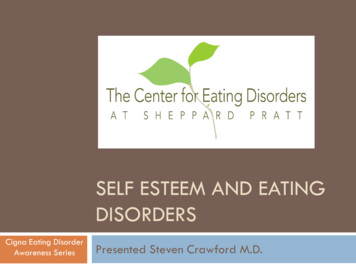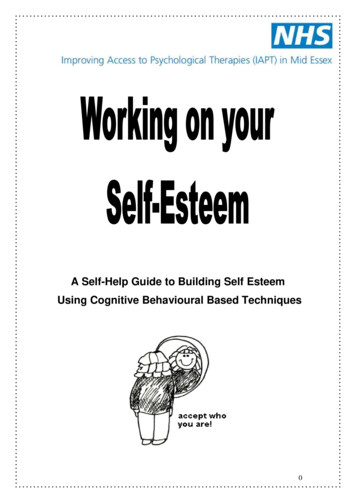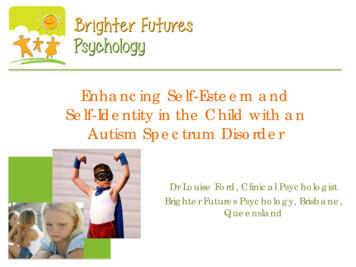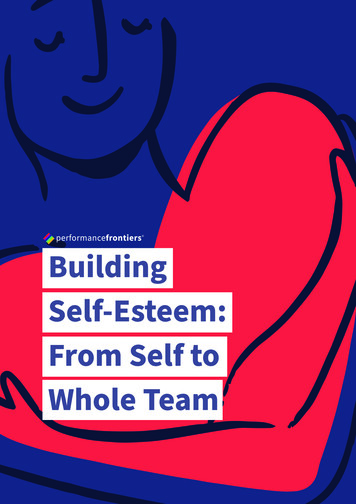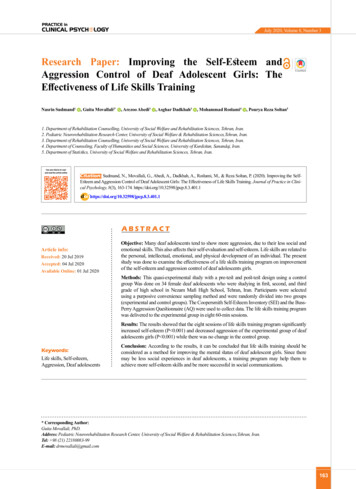
Transcription
Grades 3 to 5 Personal Health em is about more than feeling happy. Having self-esteem means recognizingyour accomplishments (what you have done) and your potential (what you can do).These ativities will help your students understand what self-esteem is.Teacher’s GuideThis guide includes: Standards Related Links Discussion QuestionsRelated KidsHealth LinksArticles for Kids:The Story on Self-Esteem Activities for StudentsKidsHealth.org/en/kids/self-esteem.html Reproducible MaterialsHow Can I Feel Better About My .htmlStandardsTalking About Your FeelingsThis guide correlates withthe following National HealthEducation Standards:Students will: Analyze the influence offamily, peers, culture, media,technology, and other factorson health behaviors. Demonstrate the ability to useinterpersonal communicationskills to enhance health andavoid or reduce health risks. Demonstrate the ability touse decision-making skills toenhance health. Demonstrate the ability to usegoal-setting skills to enhancehealth. Demonstrate the ability topractice health-enhancingbehaviors and avoid or reducehealth risks. Demonstrate the ability toadvocate for personal, family,and community ynessKidsHealth.org/en/kids/shy.htmlThe Scoop on GossipKidsHealth.org/en/kids/gossip.htmlHow Cliques Make Kids Feel Left OutKidsHealth.org/en/kids/clique.htmlDealing With Peer hy Am I So Sad?KidsHealth.org/en/kids/sadness.htmlDiscussion QuestionsNote: The following questions are written in language appropriate for sharing withyour students.1.When have you felt proud of yourself? How is self-esteem related to pride?2.If a friend makes a mistake, what would you say? If you were in that situation,what would you want people to say to you?3.When you have choices to make, how do you decide if they’re good choices?National Health /standards/index.htm 2016 The Nemours Foundation/KidsHealth. Reproduction permitted for individual classroom use.
Grades 3 to 5 Personal Health SeriesSelf-EsteemActivities for StudentsNote: The following activities are written in language appropriate for sharing with your students.Mirror, MirrorObjectives:Students will: Recognize aspects of good self-esteem, including valuing who you are and what you can do Distinguish between interests and achievements and identify how both contribute to self-esteemMaterials: "Mirror, Mirror" handoutMagazines, images printed from the InternetArt supplies (colored pencils, markers)GlueClass Time:45 minutesActivity:What achievements are you proud of? What are you good at? What are you interested in? What would you like to dobetter? Think about who you are and what you can do. Using magazine pictures, images printed from the Internet, oryour own drawings, create a collage that shows your interests, skills, and accomplishments. Think of it like a mirror:When you see your reflection, who's the person you see in the mirror and what's great about that kid?Extensions:1.“Your clothes look great!” “You’re a good listener.” “Have a nice day.” “I didn’t remember that part of the book.Thanks for reminding me.” All these things are nice things to say to someone, but which ones could affect aperson’s self-esteem? Discuss ways you can compliment someone and encourage positive self-esteem.2.Working hard can help you achieve your goals, but sometimes trying to be perfect or to do things in a perfectway can become a problem. Discuss the pros and cons of trying to be perfect. Also discuss why it can be good tomake mistakes. 2016 The Nemours Foundation/KidsHealth. Reproduction permitted for individual classroom use.
Grades 3 to 5 Personal Health SeriesSelf-EsteemFable StoryboardObjectives:Students will: Demonstrate an understanding of self-esteem and how it can affect decision-makingIdentify strategies for making healthy choices and supporting othersMaterials: Computer with Internet accessArt supplies (colored pencils, markers)"Fable Storyboard" handoutClass Time:2 hoursActivity:Write a fable in which the main character learns a lesson about self-esteem. Fables are short stories or tales thatdescribe a moral or teach a lesson. Often animals are the main characters in fables. (You may remember fables like“The Tortoise and the Hare,” in which the moral is “Slow and steady wins the race.”)Before you start, check out the KidsHealth.org articles that discuss how kids feel about themselves (self-esteem).Extension:Discuss how you'd respond to a classmate who says, “I never say anything in class because it just doesn’t comeout right.” What might you say to him or her? Make a card with some encouraging advice.Reproducible MaterialsHandout: Mirror, ng/self esteem handout1.pdfHandout: Fable rowing/self esteem handout2.pdfKidsHealth.org is devoted to providing the latest children’s health information. The site, which is widelyrecommended by educators, libraries, and school associations, has received the “Teachers’ Choice Awardfor the Family” and the prestigious Pirelli Award for “Best Educational Media for Students.” KidsHealth comesfrom the nonprofit Nemours Foundation. Check out www.KidsHealth.org to see the latest additions! 2016 The Nemours Foundation/KidsHealth. Reproduction permitted for individual classroom use.
Personal Health SeriesSelf-EsteemName:Date:Mirror, MirrorInstructions: Using magazine pictures. images printed from the Internet, or your own drawings, create a collage inside this mirrorthat shows what you see when you see your reflection: your interests, skills, and accomplishments. 2016 The Nemours Foundation/KidsHealth. Reproduction permitted for individual classroom use.
Personal Health SeriesSelf-EsteemName:Date:Fable StoryboardInstructions: Use this storyboard to write and illustrate your fable about peer pressure and self-esteem. 2016 The Nemours Foundation/KidsHealth. Reproduction permitted for individual classroom use.
Teacher's Guide: Self-Esteem (Grades 3 to 5) Subject: These activities will help your students understand what self-esteem is. Keywords: accomplishments, accomplishment, potential, self-esteem, feelings, feeling, peer pressure, worrying, worry, pride, proud,




